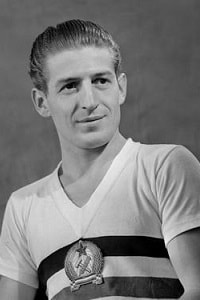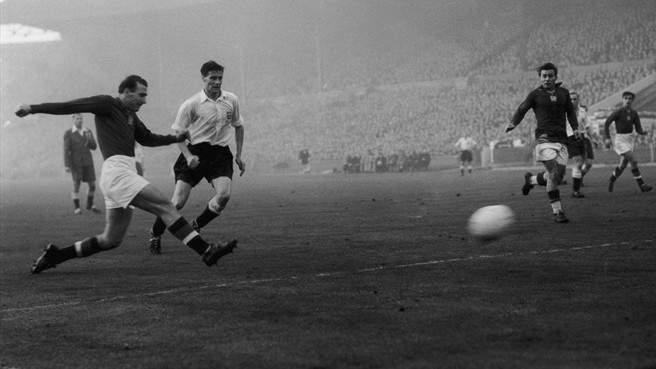145. Nándor Hidegkuti
One of the stars of Hungary’s ‘Magical Magyars’ of the 1950s, Nándor Hidegkuti was the man whose revolutionary role as a deep-lying centre forward confused defenders all across the world and helped to make the team one of the most feared in the game’s history. He helped his country to win an Olympic gold medal and reach the
World Cup final in 1954, as well as scoring a famous hat-trick in a 6-3 win over England at Wembley.
Nándor Hidegkuti was born into a middle class family in Budapest on 3 March 1922. His earliest experiences of football involved playing with a ball made from rolled-up stockings. At the age of 12, Nándor Hidegkuti joined the junior team of Újlaki FC before progressing to the senior ranks at 16, while at the same time finding work in a factory. In 1940, he joined second-tier side Gázművek, where he stayed for three years before moving on to Elektromos in 1943 and Herminamezei in 1945.

It was while with Herminamezei that Nándor Hidegkuti won his first international cap, scoring twice in a 7-2 win over Romania, but it took him a couple of years to become a regular in the team. In 1947, he signed for top flight side MTK Hungária and it was there that Nándor Hidegkuti would spent the remainder of his playing career. A highly intelligent player, he was equally competent in a variety of positions across the forward line. Often used as a winger early in his career, many of his greatest successes came in the playmaker role either as an inside forward or in the deep position which became his trademark.
Although MTK were only a mid-table side when he arrived, they gradually became one of Hungary’s top sides, with Nándor Hidegkuti’s 26 goals in 28 games in the 1948-49 season leading to a second place finish. When the Communist regime took over Hungary in 1949, MTK came to be allied with the secret police. Over the next ten years, the club ended up changing its name with some regularity and Hidegkuti represented MTK in the guises of Textiles SE, Bástya SE and Vörös Lobogó.
It was with the club playing under the name of Bástya that Hidegkuti won the first major honours of his career. Bástya claimed the league title in 1950-51, finishing four points clear of Honvéd, before adding cup success a year later as Hidegkuti scored a career high 28 league goals. Hungary were at this time building towards the 1952 Olympic Games in Helsinki and Hidegkuti sealed his place in the squad as he started to score goals with greater regularity at international level, including a hat-trick against Romania and two more against East Germany.
When the Olympics came around, a very promising Hungarian team announced themselves on the world stage in great style. With Nándor Hidegkuti on the right wing, Hungary swept through the tournament. Perhaps the most impressive result came in the semi-final against reigning champions Sweden, Nándor Hidegkuti scoring one of the goals in a 6-0 win. A 2-0 win over Yugoslavia in the final sealed the gold medals and on the back of that performance, Hungary were invited to play a friendly match against England at Wembley the following year.
It was that match that Nándor Hidegkuti would make his greatest impact. MTK’s continued success at domestic level, which brought another league title under the Vörös Lobogó name in 1953, had been built around a revolutionary style of forward play. In that system, Hidegkuti was played as a nominal centre forward but in a much deeper role, drawing the opposing centre-half out of position and leaving huge gaps for his inside forwards to exploit. With many of the players who used this system in the national team, coach Gusztáv Sebes implemented it there too and in the Wembley match, England did not know how to cope.
Hidegkuti scored in the opening minute and despite an English equaliser, added another after 20 minutes. The England defenders did not know whether to react to his new position or leave him free to roam in yards of space, but whichever they did Hungary could not be contained. Hidegkuti completed his hat-trick early in the second half, as Hungary went on to win 6-3 and emphasize their status as the best team in the world, as well as exposing England tactical deficiencies.
On a long unbeaten run, Hungary were overwhelming favourites for the 1954 World Cup in Switzerland. Nándor Hidegkuti did not play in their first game against South Korea, but was in the team for the second match against a much changed West Germany. He scored twice in the 8-3 win which sealed a quarter-final place and in that match got an early goal against Brazil to give his team a lead which they never relinquished. It seemed that the semi-final with Uruguay would be another easy win when Hidegkuti added to Zoltán Czibor’s early goal to give Hungary a 2-0 advantage, but they eventually needed extra-time to see off the holders with a 4-2 win.
With a rematch against West Germany in the final, all seemed set for Nándor Hidegkuti and Hungary to claim the world title, but despite taking a 2-0 lead inside eight minutes the Germans fought back and eventually won 3-2, ending the best chance Hungary would ever have to win the World Cup. The disappointment was enormous, but for Hidegkuti there was at least domestic success to fall back on. He helped Vörös Lobogó to win the international Mitropa Cup competition in 1955 and with the MTK name restored, another league title in 1958. He also represented the club in the inaugural European Cup in 1955-56.
Unlike many of his 1954 team-mates, Nándor Hidegkuti had remained in Hungary after the revolution of 1956 and got the chance to play in a second World Cup in 1958, aged 36. He played two of Hungary’s groups games, against Wales and Mexico, captaining the team each time. He was not present however in the play-off defeat to Wales which knocked Hungary out. The end of the tournament brought Nándor Hidegkuti’s retirement not just from international football, after 39 goals in 69 matches, but from the game as a whole.
Having retired Nándor Hidegkuti moved into coaching, initially with MTK and then in 1960 with Fiorentina in Italy. His first season in Florence was a huge success, winning both the Coppa Italia and the European Cup Winners’ Cup, after a 4-1 aggregate win over Rangers in the final. He left in 1962 to join Mantova, before returning to Hungary with Győri ETO a year later. With Győri he won a league title in his first season and the Hungarian Cup in 1965, as well as leading the team to the semi-finals of the European Cup in the same year.
Nándor Hidegkuti went on to coach several more Hungarian teams, including old club MTK, but the team struggled in the bottom half of the league. The last great success of his career actually came in Egypt with Al-Ahly. He won five titles in six years with the Cairo club before returning to Hungary in 1980, eventually ending his coaching career with a brief spell in the UAE. After suffering from heart problems, HNándor Hidegkutii died in 2002, shortly before his 80th birthday. MTK’s stadium in Budapest is named in his honour.



